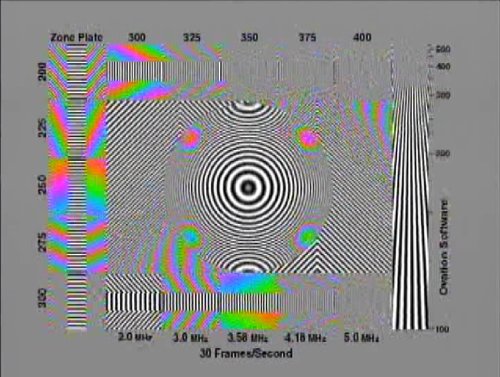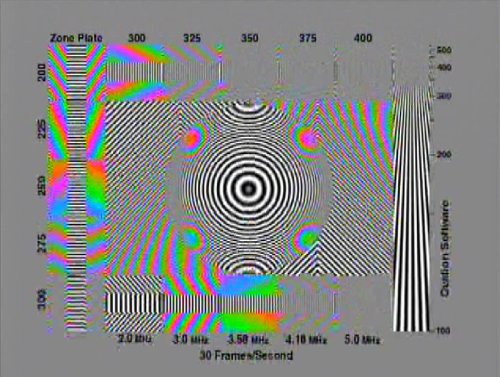The New Theater 650 TV Tuner Solution from ATI
by Josh Venning on June 14, 2006 4:00 AM EST- Posted in
- Smartphones
- Mobile
Image and Video Quality
Probably the most subjective yet important element of a TV tuner card is its ability to play and record high quality video. There are many factors involved in determining how good the video quality is and certain things like sharpness can be good or bad depending on user preference. That's why it's nice that ATI has added more user control over this and other aspects of image quality through the new software with the Theater 650.
ATI provided us with a DVD that contains some test videos to compare image quality between these three cards. To allay any suspicions of foul play, these test videos were created by SMPTE (the Society of Motion Picture and Television Engineers) for the express purpose of testing analog television quality. These videos include still and moving images to test how well a tuner applies things like sharpness and noise reduction. We recorded all of the tests with each of the tuners to provide a consistent test video for comparison between cards, and you can download the complete videos using your favorite BitTorrent client. (Total size of the three videos is 345 MB.) Note that we used ATI's AVIVO utility to convert all of the files to MPEG-4 format from the default MCE .ms MPEG-2 format. This was done to reduce file size, and we did verify that there was no discernible change in image quality (the original files totaled over 1 GB in size). In order to avoid any errors in our own analysis, we used the original files while drawing our conclusions.
It is also important to point out that we didn't just run a DVD player straight into a composite video input. We ran our DVD player through a modulator set up to output on channel 3. This way were were able to provide each card with a source data in the same format as if the images were broadcast and recieved over a cable connection. Feeding in analog video directly would bypass the tuner and demodulator on the card and wouldn't present a full test of the hardware, but our solution gives us the ability to repeat tests easily using a reliable source. The images below are taken from the original video files.
As we mentioned in the introduction, ATI has improved their 3D comb filter with the Theater 650 over the 550 by making it motion adaptive. This means that moving objects will be much cleaner and sharper compared to those without this feature. As you can see in the above images, the fruit in the Theater 650 capture looks similar to the 550, but the color is cleaner, especially near the edges of the tomato. You can also see that the DualTV has some problems with displaying the edges of the tomato and stand properly while in motion. This is one case where we see a clear improvement by ATI over NVIDIA in image quality.
In the above images, we can also see how there is slightly more detail in certain areas of the test pattern with the Theater 650 compared to the 550, and both are ahead of the DualTV. The loss of detail is noticeable near the upper and lower right hand corners of the image where some of the fine lines tend to blur together. There are also fewer color artifacts with the Theater 650 due to its higher quality 3D comb filter.
As a final example, we can see the difference in the color between the Theater 650 and 550 in these images, and the 650 gives the woman's skin tones a better treatment. There isn't a very big difference here between the Theater 650 and DualTV but you can see how the colors are generally brighter on the Theater 650 due to the new automatic color control.
These are only some of the tests on the DVD (there are eight tests in all) which demonstrate the Theater 650's better overall image quality than the 550. From these results we can definitely see how ATI has improved over the 550 as well the DualTV with their new Theater card.
Probably the most subjective yet important element of a TV tuner card is its ability to play and record high quality video. There are many factors involved in determining how good the video quality is and certain things like sharpness can be good or bad depending on user preference. That's why it's nice that ATI has added more user control over this and other aspects of image quality through the new software with the Theater 650.
ATI provided us with a DVD that contains some test videos to compare image quality between these three cards. To allay any suspicions of foul play, these test videos were created by SMPTE (the Society of Motion Picture and Television Engineers) for the express purpose of testing analog television quality. These videos include still and moving images to test how well a tuner applies things like sharpness and noise reduction. We recorded all of the tests with each of the tuners to provide a consistent test video for comparison between cards, and you can download the complete videos using your favorite BitTorrent client. (Total size of the three videos is 345 MB.) Note that we used ATI's AVIVO utility to convert all of the files to MPEG-4 format from the default MCE .ms MPEG-2 format. This was done to reduce file size, and we did verify that there was no discernible change in image quality (the original files totaled over 1 GB in size). In order to avoid any errors in our own analysis, we used the original files while drawing our conclusions.
It is also important to point out that we didn't just run a DVD player straight into a composite video input. We ran our DVD player through a modulator set up to output on channel 3. This way were were able to provide each card with a source data in the same format as if the images were broadcast and recieved over a cable connection. Feeding in analog video directly would bypass the tuner and demodulator on the card and wouldn't present a full test of the hardware, but our solution gives us the ability to repeat tests easily using a reliable source. The images below are taken from the original video files.
As we mentioned in the introduction, ATI has improved their 3D comb filter with the Theater 650 over the 550 by making it motion adaptive. This means that moving objects will be much cleaner and sharper compared to those without this feature. As you can see in the above images, the fruit in the Theater 650 capture looks similar to the 550, but the color is cleaner, especially near the edges of the tomato. You can also see that the DualTV has some problems with displaying the edges of the tomato and stand properly while in motion. This is one case where we see a clear improvement by ATI over NVIDIA in image quality.
In the above images, we can also see how there is slightly more detail in certain areas of the test pattern with the Theater 650 compared to the 550, and both are ahead of the DualTV. The loss of detail is noticeable near the upper and lower right hand corners of the image where some of the fine lines tend to blur together. There are also fewer color artifacts with the Theater 650 due to its higher quality 3D comb filter.
As a final example, we can see the difference in the color between the Theater 650 and 550 in these images, and the 650 gives the woman's skin tones a better treatment. There isn't a very big difference here between the Theater 650 and DualTV but you can see how the colors are generally brighter on the Theater 650 due to the new automatic color control.
These are only some of the tests on the DVD (there are eight tests in all) which demonstrate the Theater 650's better overall image quality than the 550. From these results we can definitely see how ATI has improved over the 550 as well the DualTV with their new Theater card.



















78 Comments
View All Comments
pjladyfox - Wednesday, June 14, 2006 - link
She actually. ^__^The one thing that really irked me over the 550, which pretty much forced us to go with the X1800 AIW instead, is that without MCE 2005 it was not a very useful card. Heck, we did'nt even have the fallback of the Multimedia Center, which a lot of us who have had either ATI AIW or their stand-alone TV tuner learned to live with, and instead got shafted with the terrible bundled software. :P I mean, come on, if you bundled the nice Adobe software with the AIW why not at least do it with your tuner cards instead of pawning off the third-rate discount bin stuff?
In either event I'm hoping that whoever did this article re-labels this one since this is definatly NOT a review in any sense of the term.
LoneWolf15 - Thursday, June 15, 2006 - link
Ouch! I'm so sorry. No disrespect intended. :)
That's why at the time I went with a Hauppauge WinTV PVR-150. My TV Wonder PCI is fine for just watching (provided you use very specific versions of ATI's MMC software, as some have seriously broken the audio setup in their push to go from analog to digital across the PCI bus) but all the software solutions I saw were most compatible with Hauppauge boards at the time over the Theater 550. In fact, GB-PVR, my personal favorite, is great when paired with any PVR-xxx card. Bonus: it's free.
I got a ReplayTV on the cheap with a lifetime subscription, so I dismantled my HTPC. Still, I'd love to replace my TV Wonder with a good card for casual use in my main system. With the lack of information on DVR and Catalyst Multimedia Center, this card won't be it. And I'm in full agreement of you that this article does NOT constitute a review.
SHSPVR - Wednesday, June 14, 2006 - link
In ABC it all get this error6/14/2006 11:35:54 AM - Problem connecting to tracker - (10049, "Can't assign requested address")
hondaman - Wednesday, June 14, 2006 - link
I fail to understand why you think its acceptable to leave out the DEFACTO capture card. AGAIN. Hauppauge is the clear industry giant in video capture, and you publish another article, flippantly referencing us to your previous review of the card. Image quality is subjective, and its important to allow us to see, and judge, the image quality instead of your "just trust me" attitude.Leaving hauppauge out of a capture card review would be like reviewing ATI's latest video card, and comparing it to SIS instead of nvidia.
Myrandex - Wednesday, June 14, 2006 - link
One disappointing *feature* I discovered on my Theater 550 PCIE that is EXTREMELY IRRITATING is lag with the video in ports. I tried hooking up a game system to it, and if I hit the jump button for example, I would have to wait a little bit for my character to jump. I'm not talking anythign like either, I'm talking extremely noticeable. Itried contacting powercolor help, and they said update drivers (already did) and somethign else, and then quit responding to me. Is there anyway that this can be tested as if I would have known this ahead of time, I don't think I would have purchased it.nvmarino - Wednesday, June 21, 2006 - link
If you want to connect a game console to your display via your PC you want one of these:http://www.simplifidigital.com/shopsimplifi/index....">http://www.simplifidigital.com/shopsimp.../index.p...
As others have commented, tuners cards (especially those with hardware encoders) are not designed for this.
mattsimis - Wednesday, June 14, 2006 - link
I agree, I had to get rid of my Theater 550 setup (and seems 650 is as bad) and swap back to a 7year old Brooktree 878 based TV Capture card due to the lag. The BT878 has a delay of about less than 100msec, its excellent.I have to use the Svideo Input on TV Cap Cards as the Satelite TV service here (Sky "Digital") uses encrypted signals that can only be decoder on their decoder box. Once you decode it, you can output the raw video signal (SCART RGB to Svideo adapter). I then input this into DScaler. Image quality was a bit better on the Theater 550, however the lag was unusable.
From the article it seems the lag isnt just on the Video Inputs, but the TV Tuning too, so contary to the other reply, seems everyone will notice it. Cant understand how a 2000msec delay is considered "ok" for product release.
Matt
BigLan - Wednesday, June 14, 2006 - link
"Cant understand how a 2000msec delay is considered "ok" for product release."These types of TV cards are designed for watching TV (not video games) and specifically for timeshifting/recording TV using a PVR application with a built in TV Guide, so channel surfing isn't necessary. For that purpose a 2 second delay doesn't really matter.
What you want is a transcoder, which is a different beast altogether.
sirfergy - Wednesday, June 14, 2006 - link
That is because it has to encode the signal. You aren't supposed to use it as a video input to your computer for consoles.Crucial - Wednesday, June 14, 2006 - link
Your choice to not include the Hauppage cards was a slap in the face of everyone who asked for them and nothing short of a joke. The Hauppage cards are by far the more popular product and it would make more sense to compare them for those of us who might buy the new card if they infact are better. If your video card reviews followed the same pattern as your tv tuner reviews you would be the laughing stock of the internet. We want a screenshot of the apple, pattern and girl on a hauppage card to see for ourselves which card looks better. I'm guessing the couple of years old pvr150 would look better than all of them and ATI wouldn't let you show it. If not then do a couple more tests and update the review.As for the DTV portion of these cards, I'm sorry that you don't get DTV reception in your area but I couldn't care less. Millions of us do and use it. If Anandtech is going to be a top quality review site they need to find a reviewer who can get it. Important things to know about the DTV would be can a digital and analog channel be recorded at the same time? What kind of cpu usage does the tuner use when recording both or watching an analog and watching a digital? Can MCE use 2 of these cards and record 2 analog and 2 digital channels at once?
Each time I see these reviews I hope you change you tune and do a real comparison of whats out there and being used instead of being the puppet for the corporation thats giving you free product to play with.